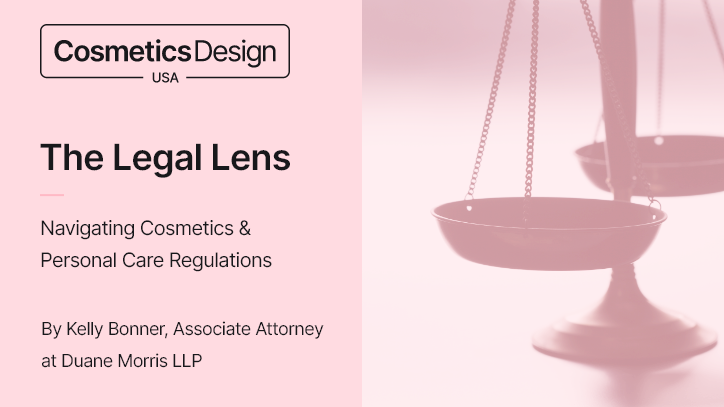Hi! My name is Kelly, and I am many things: a mother of two boys; a cat lady; a bookworm; the owner of a truly frightening collection of secondhand designer shoes; and a certifiable beauty obsessive.
In my professional capacity, however, I am a lawyer, and my practice focuses on litigation risk and regulatory issues affecting businesses in the cosmetics and personal care industries. Which is what brings me here today, in the first installment of a new feature here with Cosmetics Design USA: a column dedicated to all things legal, regulatory, and—hopefully—fun and interesting in the beauty space.
This is a safe space, where no one is required to have taken Con Law or AP Chem (you may be entitled to emotional support if you did). Anything said here is meant to be entertaining and educational—not intended as formal legal advice. Any opinions I express are personal, and not intended to speak for FDA or any institutional entities (except, maybe, the Swifties).
Without further ado, let’s jump into some of the basics: how cosmetics are defined and regulated here in the U.S.
What are cosmetics, according to U.S. regulators?
Great question—glad you asked.
It’s important to remember that the regulatory definition of “cosmetics” is much broader than you’d normally think.
“Cosmetics” are defined by the federal Food, Drug, and Cosmetic Act (FDCA)as “articles intended to be rubbed, poured, sprinkled, or sprayed on, introduced into, or otherwise applied to the human body . . . for cleansing, beautifying, promoting attractiveness, or altering the appearance.”
This definition includes skin moisturizers, perfumes, lipsticks, fingernail polishes, eye and facial makeup, cleansing shampoos, permanent waves, hair colors, and deodorants, as well as any substance intended for use as a component of a cosmetic product.
This definition does not include products intended for therapeutic purposes, such as treating or preventing disease, or products that affect the structure or function of the body. These products are considered drugs, which are subject to more stringent regulatory oversight. Some products, like products that contain sunscreens, or anti-acne creams, may be regulated as both cosmetics and drugs.
How are cosmetics generally regulated in the United States?
Cosmetics intended for sale in the United States are regulated in two ways:
First, cosmetics are regulated at the federal (i.e. national) level under the FDCA, which was enacted in 1938 and authorizes the Food and Drug Administration (FDA) to regulate and ensure the safety of cosmetics.
The FDCA requires finished cosmetic products to be safe when used in accordance with product labeling or customary usage, and to not be “misbranded” or “adulterated” when introduced into interstate commerce (meaning it’s sold across state borders). “Misbranded” generally means that the labeling or packaging is false, misleading, or fails to comply with certain regulatory requirements, while “adulterated” means … generally what you think: it shall not be prepared under unsanitary conditions, contain any poisonous or injurious substance—looking terrible doesn’t count as injurious—or contain any unsafe color additives.
Additionally, cosmetics must comply with the Fair Packaging and Labeling Act (FLPA) (1966), which requires cosmetics marketed on a retail basis to be honestly and informatively labeled, as well as regulations promulgated by FDA under the authority of the FDCA and FLPA.
On December 23, 2022, Congress enacted the Modernization of Cosmetics Regulation Act (MoCRA)—the first major statutory change to U.S. federal government’s ability to regulate cosmetics since the moon landing. Passed with bipartisan and industry support, MoCRA expands the FDA’s authority over cosmetics, and creates substantial new obligations for manufacturers, packers, and distributors of cosmetics intended for sale in the United States. But we’ll get into that in another column.
Finally, cosmetics also are regulated at the state level, where they are subject to certain ingredient listing requirements such as California’s “Prop 65,” or prohibitions on the use of certain intentionally added ingredients, like formaldehyde, mercury, and perfluoroalkyl and polyfluoroalkyl substances (PFAS).
So that’s it?
No, that’s just the basics—we’re just getting started!
There’s so much more to cover in this space, from discussing what MoCRA means for manufacturers and distributors, to understanding what courts and regulators have said about various claims beauty brands can make, to considering FDA warning letters and unapproved skincare products, to examining the whole “Sephora tween” phenomenon and learning what legislators have to say. So please stay tuned—there’s lots to talk about.
Until then,
Kelly

